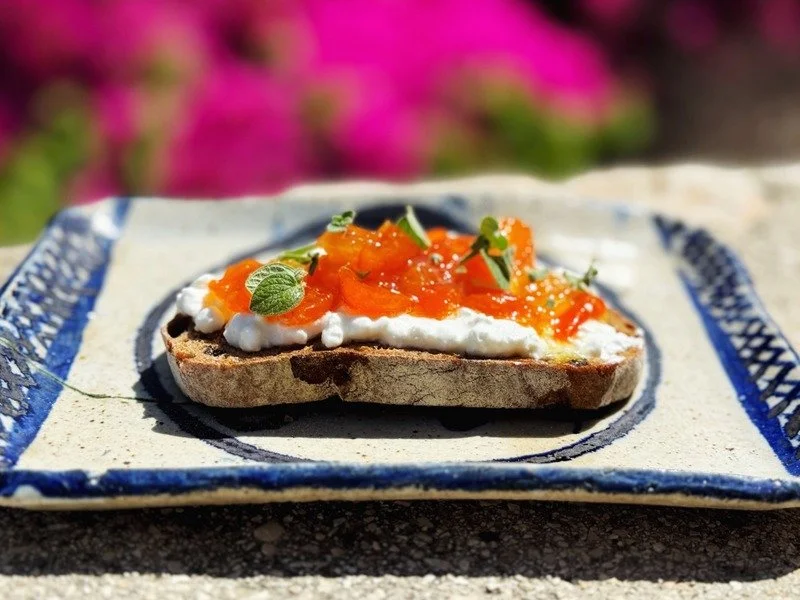One year ago Hungarian Creamed Spinach
SUMMER
It’s summer here, no doubt about it, but no holidays yet!
In addition to summer fruits in the markets, there’s been so much work that I have not been able to finish the next remarkable grandmother’s life story - so it's a recipe without a Survivor’s story this week.
As a consolation, I am including one of the feature stories I have been working on, which is also food related. Well, back to the source. It’s about seeds.
SEED LIBRARY
A vital new project was inaugurated in the West Bank last week: a national Seed Library. Palestinian botanist, Vivien Sansour is collecting heirloom seeds, in a bid to stop them disappearing from local fields -- and history. And who holds the seeds – and the knowledge? The community’s elders, of course, so there are a lot of resonances for Food is Love.
Heirloom radishes, destined for Bethlehem markets, washed in springwater after they were picked in the village of Wadi Fukin. The fields belong to farmer Mahmoud Mifreh, known as Abu Diyaa, below left. That's Seed Library founder Vivien Sansour, her arms full of radishes, below right.
I spent a week with Vivien Sansour as she went out searching for older Palestinian farmers – like a seed detective. She met one farmer, Abu Diyaa harvesting heirloom radishes, which he grew on a small plot along with a number of other vegetables, including spinach, onions and the local white cucumber, which is rarely grown any longer. And yes, that wooden stick you can see is as high tech as it gets in the washing process!
Along the way, I learnt a lot about GM vs organic crops, and old-style farming and inter-cropping, to minimise the need for pesticides, as well as irrigation methods going back thousands of years – to the days of the Canaanites! I also got to spend time in very beautiful areas of the West Bank, in and around Bethlehem, where it looks like time stood still not long after the Canaanite era.
Planting new seeds in a field beneath the village of Battir, a World Heritage listed area. The field is being reclaimed for the Seed Library project by another hardy elderly farmer. Abu Elabed uses only 2 pieces of equipment - a hoe and a rake. The railway track at the bottom of the field is where the Jerusalem-Tel Aviv train runs.
For the first time, I ate green humus, from the pod, like peas. You can only do it now, in the month they’ve been harvested. I also learnt about a local watermelon which once grew from here to Syria, and which has almost disappeared. Vivien is now trying to revive it.
Below, Green humus - delicious! - and Vivien planting the nearly extinct Jaduyi watermelon. She grew the seedlings from 7 year old seeds given to her by a farmer in the Northern West Bank.
WATCH AND LISTEN
So this is modern journalism, producing the same story in different formats. You choose which you prefer!
I've done a TV story for the English service of France 24, which you can see by clicking on this link:
I've also done a radio story for ABC RN Life Matters, which you can hear by clicking on this link:
http://www.abc.net.au/radionational/programs/lifematters/palestinian-seed-library/7488928
VINE LEAVES
One morning, while I was working on this story, I walked my dogs in the wadi beneath my house, and saw a woman picking vine leaves. I knew she was serious, because she had her husband out picking too… so I asked her what she was up to.
Aliza turned out to be an Israeli from an Iraqi family and a caterer, and she was picking the leaves so she could stuff them of course. She was happy to give me her recipe, along with very precise instructions. Her vine leaves are slightly different from the way Food is Love grandmother Rina Mevorach prepares them.
Rina's recipe is on our website, where she teaches her grand-daughter the vine-leaf folding secrets --
Intense concentration as Jerusalem grandmother Rina Mevorach prepares vine-leaves with her grand-daughter Enelle Mevorach. No mistakes allowed!
Aliza's vine leaves were also different from the way that Um Saleh from the village of Arrabe made them, which I wrote about in a blog post last October. Um Saleh stuffed vine leaves and zucchini on the day I was there, along with a group of Americans and Israelis she'd invited into her home. My old mate from Melbourne Paul Nirens, who's lived in the Galilee for the past 25 years, has set up a business called Galileat. He takes Israelis to Arab villages in the Galilee to learn about their neighbours’ food and their lives, and also along the way, empowers local women.
You can see Um Saleh's recipe here --
http://www.foodislove.co/blog-1/galilee-cooking-class11102015
And since all 3 are vegetarian - in fact vegan - versions, it makes me realise that there as many different stuffed grape leaves recipes as there are women preparing them! It’s about the spicing and the ratio of leaf to rice – more rice with Greeks and Libyans, more leaf with the Iraqi Kurds and Galilee Palestinians.
So the next morning I was inspired to go out and pick vine leaves, accompanied by my dogs. And although they are not as much help as a husband or boyfriend, it didn't take long.
Back home I rinsed the leaves and then poured boiling water over them, and let them stand for an hour. They pretty quickly go from that bright green to a darker olive colour, and release the sour smell I associate with vine leaves too.
Aliza's Stuffed Vine Leaves
Makes 100
INGREDIENTS for filling
- 1 1/2 cups white rice – rinsed well
- 2 tablespoons olive oil
- 2 medium size ripe tomatoes, skinned and grated
- 4 green onions
- 2 large celery leaves ie the leaves from 2 stalks (can substitute any green such as spinach, parsley, or coriander)
- 1 flat tablespoon salt
- 1/2 teaspoon pepper
note on rice
Aliza uses shortgrain rice. I've made it with both and prefer long grain rice as it holds its shape better and doesn't go so mushy. But if you wanted it to cook more quickly, short-grain could be useful.
NOTE ON LEAVES
Vine leaves have 2 sides. The top side, which is smoother and the underside which is veiny. To fill them, you place them top side down ie so the filling goes on the veiny side and then you see the smooth side when they are rolled up.
ingredients for pot
- 100 vine leaves
- 1-2 tomatoes for the pot
- 2 tablespoons oil
- 1 teaspoon each salt, pepper and sweet paprika
- 1 plate which will fit inside the pot, to hold them down
method
1. Slice tomatoes and put in bottom of pot. This is to prevent the rolls from sticking to the bottom of the pot. You can also add any torn vineleaves or some celery leaves here.
2. Mix the filling ingredients and then put one teaspoon per leaf ie less than you think you will need, as the rice really swells.
3. Fold. This is the tricky bit! Have the leaf flat in front of you, like a map of Australia, veiny side up. Put the mixture in a line across the leaf horizontally ie across the centre of Australia, and then fold it – first roll the bottom up, second the left side over, then the right side over, then roll up like a cigar. Aliza then squeezes each one out, over the pot, so that the cigar is tight and the pot has the benefit of the juice. Lay them next to each other, as close as possible.
NB: If you still aren’t sure, there are pictures on Rina Mevorach's recipe – go take a look.
4. When you have filled all the leaves, cover the cigars with boiling water. Add oil, salt, pepper and paprika. Put a plate which fits inside the pot on top so they don’t unravel and float away. Bring to the boil, then turn down the heat till low and simmer for 2 hours. The rice cooks quickly, you are actually cooking the leaf, and making sure all the flavours become absorbed.
jerusalem test kitchen
I made these twice, and although Grandma Rina promised that I could freeze the boiled leaves and then thaw them, I found it didn't work. They became fragile and broke after they'd thawed.
I would recommend knuckling down and doing it all at once. It's a lovely job to do with someone – mother, aunt, sister, grandmother, friends. Your hands are occupied, but you can still enjoy talking and in the end you have a big pot of stuffed vine leaves to share.
oTHer grains?
I would like to try them next with different grains eg buckwheat or burghul – or even something less familiar. I can't consult any of the grandmothers - they think I'm mad. "No, we always make this with white rice," is their stock response, before going on to explain that nothing else will work as well and there's no point wasting my time.
I decided to check in with Grain Guru Maria Speck (check out her blog here and if you don’t know her whole grain cook books you are in for a treat.) As well as being innovative with cooking with grains, her mother is Greek, so she'd know vine leaves. I was thrilled when she replied promptly. Speck says that burghul is also classically used as a filling. She warns that my other favourite, buckwheat (kasha) could become too mushy, and suggests trying quinoa. Will have a play around and report back.
#EATLOCAL
But may take home message from this busy week is grow local, with as few chemicals or pesticides as possible, and eat local. If you eat fresh food, in season and prepare it yourself, you will be fit, healthy and happy as a Queen (or King). And likely live to 90, like the Food is Love grandmothers, and other Royals whose birthdays we celebrate.


































